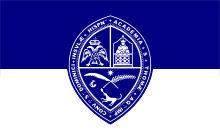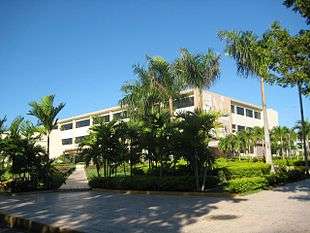Universidad Autónoma de Santo Domingo
See also Universidad Santo Tomás de Aquino
| Motto | Neo Mundi Decanatus (Latin) |
|---|---|
Motto in English | Dean of the New World |
| Type | Public |
| Established | October 28, 1538 |
| Rector | Ivan Grullon |
| Students | 170,530 (2010) |
| Location | Barahona, Bonao, Duvergé, Hato Mayor, Higüey, La Vega, La Romana, Mao, Nagua, Neiba, Puerto Plata, San Francisco de Macorís, San Juan de la Maguana, Santiago, San Pedro de Macorís, Santiago Rodríguez, Santo Domingo (flagship) |
| Campus | Urban |
| Colors | Blue and white |
| Nickname | UASD |
| Website | http://www.uasd.edu.do |
The Universidad Autónoma de Santo Domingo (UASD) (Autonomous University of Santo Domingo) is the public university system in the Dominican Republic with its flagship campus in the Ciudad Universitaria of Santo Domingo and with regional campuses in many cities of the Republic. It was reopened and renamed in 1914, replacing the former Universidad Santo Tomás de Aquino, the first university of the Western Hemisphere (Americas), which was founded unofficially by a Papal bull in 1538, officially by royal decree in 1558, and closed in 1832.
In structure, the school followed the model of the University of Alcalá de Henares. The university organized its offerings into four schools: Medicine, Law, Theology, and the Arts. Today, the University has expanded to eight schools: Humanities, the Arts, Law and Political Science, Health Sciences, Economics and Social Sciences, Science, Engineering and Architecture, and Agricultural Sciences.
History
The University of Santo Tomás de Aquino was created by means of the papal bull In Apostolatus culmine, dated October 28, 1538, from Pope Paul III, who raised to a university the seminary that the Dominicans had been operating from 1518 in Santo Domingo, the seat of the viceroy and the oldest colony of the New World.
The new University was organized in four schools: Medicine, Law, Theology, and Arts. The studies in Arts included the two traditional curricula, namely: the trivium consisting of grammar, rhetoric, and logic; and the quadrivium, which is arithmetic, geometry, astronomy and music .

Troubles
In the year 1801 as a consequence of the Haitian occupation of the country, the University ceased operating. It was reopened in the year 1815, as the colony returned to the Spanish authority, but from then on it was a secular institution.
Between 1815 and 1821 the president was Dr. Jose Núñez of Caceres. The University again closed its doors in 1822 due to the fact that a great number of students were recruited for military service on order of the Haitian regime governing the nation.
With the consummation of the independence of the Republic in 1844, the will to restore the university was reborn in the Dominicans. Accordingly, on June 16, 1859, President Pedro Santana promulgated a law to restore the former, university, with an academic composition similar to that of the medieval universities (with four areas of education: philosophy, jurisprudence, medicine and sacred letters), under the authority of the government. In 1866 the Professional Institute was created, which functioned as a replacement of the previous University of Santo Domingo.
In 1891 the Professional Institute closed its doors until 1895, when it reappeared under the presidency of Archbishop Meriño.
On November 16, 1914, the president of the Republic, Dr. Ramon Báez, who was also Rector of the Professional Institute, decreed the transformation of the Professional Institute to the University of Santo Domingo.
From 1916 until 1924 the University's function was interrupted as a consequence of the United States occupation.
Autonomy
After the death of Trujillo, a law passed in 1961 provided autonomy to the University. From this point a debate began on how to reach the balance between institutional power and social responsibility to allow it to develop all its creative powers. After three decades, however, bent to the iron will of a regime opposed to any form of human communication that was not subservient to its own interests, it was unable to use the freedom and newly acquired self-government effectively.
Faculties
Humanities [1]
The Humanities Faculty is formed of the Schools of Social Communication, Philosophy and Anthropology, History, Foreign language, Literature and Psychology.

The authorities for the period 2008–2011 are:
- Dean: Prof. Rafael Morla de la Cruz
- Deputy Dean: Prof. Amelia Milagros Salas
- Director of Social Communication School: Prof. Patricio Jovanny Matos
- Director of Philosophy School: Prof. Francisco Acosta
- Director of History and Anthropology School: Prof. Dioris O. Antigua Correa
- Director of Literature School: Prof. Ramón Morel Félix
- Director of Pedagogy School: Prof. Maestro Víctor Encarnación
- Director of Psychology School: Prof. Yosijo Docar Ajitas
- Director of Professional Orientention School: Lic. Irenes López Severino
- Director of Foreign language School: Prof. Ramón E. Rodríguez Espinal
- Director of Postgraduate education:
Agronomy and Veterinary Sciences [2]

The Agronomy and Veterinary Sciences Faculty is formed of the Schools of Agronomic Engineering, Zootechnics and Veterinary Science.
Laws and Political Sciences [3]
The Law and Political Science Faculty is formed of the Schools of Law and Political Science.
The Law and Political Science Faculty award the titles of Licentiate in Law and Licentiate in Political Science; the latter has three majors: Internationals Studies, Socioeconomics Studies and Internationals Relationship. The Criminology Institute is a part of the Faculty.
Economics and Social Sciences [4]
By Law 4412 of 24 March 1956 the University Organization Law of 21 October 1937 was modified, adding the Economics and Commerce Faculty to the existing faculties. The new faculty would award the degrees of Licentiate in Commercial Science and Doctor in Economics and Commercial Science.
At the same time, Law 4413 decreed that the four courses "of the second cycle of the Superior School of Accountant Technician, established by the decree 2383... were assigned to the Economics and Commerce Faculty of the Santo Domingo University from 12 October 1956, under the name of Commercial Science Department".
The Law 4439 dated 4 May 1956 changed the name of the "Economics and Commerce Faculty" to the "Economics, Finance and Commerce Faculty". This same law authorized to the graduates of the Superior School of Accountant Technician, with the title of Accountant Technician "provides them with licence to practice the profession of Authorized Public Accountant and carry the title in Commercial Science and allows them to opt for the Doctorate in Commercial Science by the presentation of a thesis, following the regulation dictated by the University Council".
In 1950, Law 5130 changed the "Economics, Finance and Commerce Faculty" to the "Economic Science Faculty" and included the Public Administration School. The Organic statute approved by the University Cloister in 1966, gave the faculty with its current name of the "Economics and Social Sciences Faculty".
Currently, the Economics and Social Sciences Faculty is formed of the Economics, Accountantcy, Statistics, Sociology, Marketing and Administration schools.
The authorities for the period 2008–2011 are:
- Dean: Prof. Juan Antonio Cerda Luna
- Deputy Dean: Prof. Ramón Desangles
- Director of Economics School: Prof. Melvin Pérez Sarraf
- Director of Administration School: Prof. Alixis Martínez
- Director of Marketing School: Prof. José Antonio Burgos
- Director of Accountant School: Prof. Norberto Hernández
- Director of Statistic School: Prof. Francisco Roa Familia
- Director of Sociology School: Prof. Marisela Duval Pérez
- Director of Postgraduate:
Engineering and Architecture [5]
The Engineering and Architecture Faculty is formed of the Architecture, Electromechanics Engineering, Civil Engineering, Chemical Engineering, Surveying and Industrial Engineering schools.
Sciences[6]
The Science Faculty is constituted of the Biology, Geographic Science, Physics, Mathematics, Microbiology and Parasitology, Chemistry and Computing schools.
Health Sciences[7]
The Health Sciences Faculty formed of the Pharmacy, Imaging, Infirmary, Odontology, Bioanalysis, Medicine, Public Health, Nursing, Physiology and Morphology schools.
The Arts[8]
The Arts Faculty is formed of the Criticism and History of Art, Publicity, Theater, Music, Film, Television and Photography, Industrial Design and Fashion and Plastic Arts schools.
University authorities, 2011–2014
Rector: Dr. Ivan Grullón.
Educational vice rector: Dr. Jorge Asjana David.
Vice rector of Research and Postgraduates: Ma. Francisco Vegazo.
Administrative vice rector: Ma. Emma Polanco.
Vice rector of Extension: Ma. Francisco Terrero Galarza.
Notable people
Faculty
- Mateo Morrison, writer, lawyer, poet and essayist.
- Fabio Fiallo (member of the Faculty of Law with the then Instituto Profesional de Santo Domingo), diplomat, writer, poet
References
- ↑ Facultad de Humanidades (Spanish)
- ↑ Facultad de Ciencias Agronómicas y Veterinarias (Spanish)
- ↑ Facultad de Ciencias Jurídicas y Políticas (Spanish)
- ↑ Facultad de Ciencias Económicas y Sociales (Spanish)
- ↑ Facultad de Ingeniería y Arquitectura (Spanish)
- ↑ Facultad de Ciencias (Spanish)
- ↑ Facultad de Ciencias de la Salud (Spanish)
- ↑ Facultad de Artes (Spanish)
External links
| Wikimedia Commons has media related to Autonomous University of Santo Domingo. |